- May 20, 2022
- Beef
Tri Tip VS Picanha: Which Cut of Meat is Right For You?
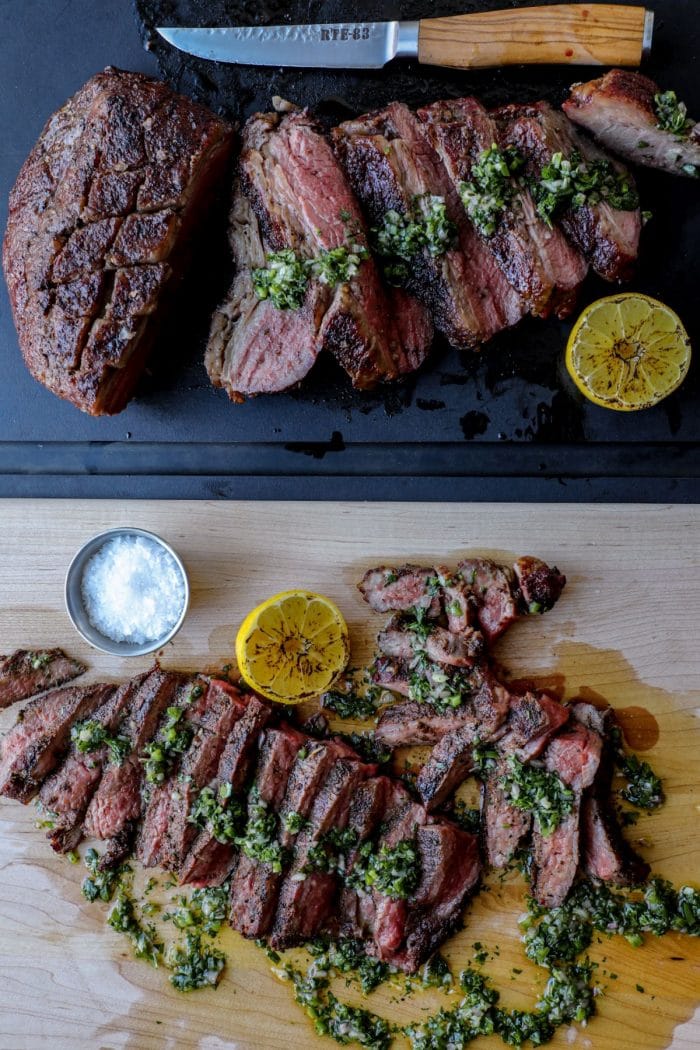
Wondering which of these two popular cuts of beef is best for you? Here’s everything you need to know about tri tip vs picanha, including purchasing, seasoning, prepping and the best ways to grill and smoke them too.
If you love to entertain or you just want a lot of steak (for less money), then chances are you have contemplated smoking or grilling a tri tip or a picanha cut of beef.
But, which cut is actually right for you?
There are many different factors to consider:
- Availability
- Cost
- Preparation Methods
- Flavor
- Traditional vs Non-Traditional cooking
Today we are comparing and contrasting everything you need to know about these two cuts, where they come from, how they differ, the best methods for indoor and outdoor cooking, and how to ultimately make a delicious and flavorful steak as the end result.
While this article is going to give you a much more in-depth and educational background on these two cuts, you can also check out my full recipes for reverse seared picanha or my two variations on tri tip (tri tip on a gas grill and smoked tri tip using a charcoal grill).
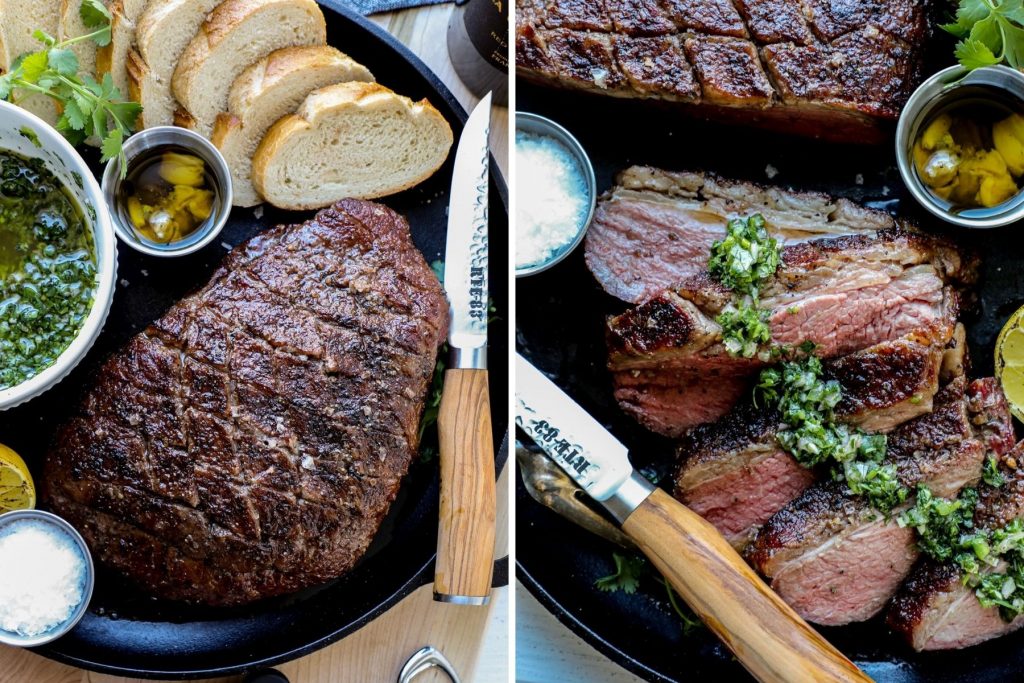
New to BBQ or just getting comfortable breaking in your grill?
Sign up for this free downloadable guide to the Bon Appeteach BBQ Basics. It’s a comprehensive guide to the fundamentals of BBQ.
This guide goes in depth on steak cooking techniques, with a focus on cooking temperatures for doneness and the highly coveted reverse sear method which will be touched on below.
Sign up for free to help you cook a better picanha or tri-tip steak!

Let’s dive into our Tri Tip VS Picanha and everything you need to know with this helpful FAQ!
No, tri tip and picanha are actually different cuts of meat. Tri tip is a leaner cut of meat with less fat, while picanha is a fattier cut of meat with more marbling.
While they both can be categorized as a sirloin cut, they do come from different parts of overall sirloin (making them very different in flavor, marbling, and texture).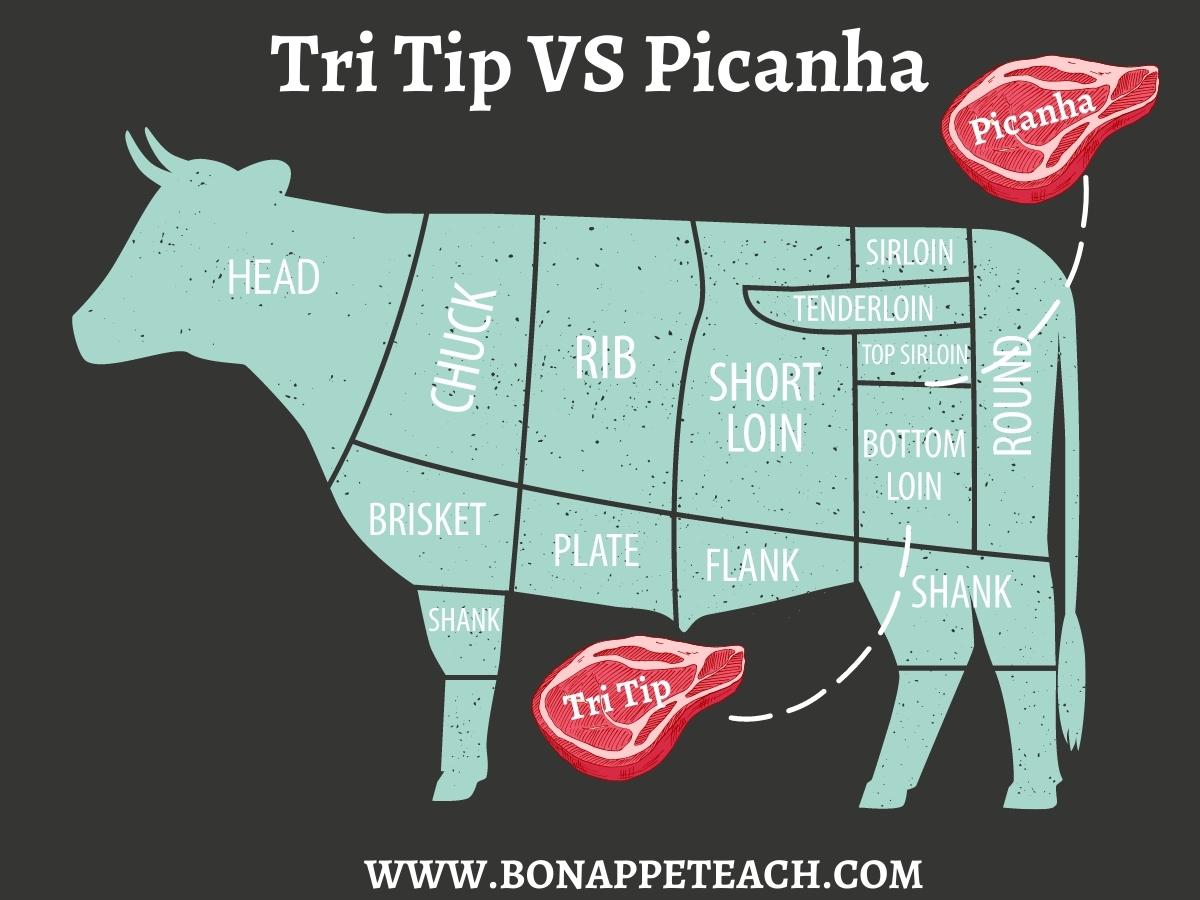
Tri Tip:
– Also known as a triangle steak (because of the triangular shape), this cut of meat comes from the bottom sirloin.
– It’s a leaner cut of meat with less fat.
– It’s a versatile cut of meat that can be grilled, roasted, or even smoked.
– Tri tip is a great option if you’re looking for an affordable way to serve a steak style protein to a larger group.
– Can sometimes be hard to find depending on where you live in the United States (common cut found mostly in the western U.S).
– Traditional style is prepared using the santa maria steak method for flavoring and cooking.
Picanha:
– Also known as a top sirloin cap steak, this cut of meat comes from the top sirloin.
– It’s a fattier cut of meat with more marbling and a thick fat cap over the top.
– Sometimes referred to as a Coulotte steak.
– It’s best cooked over high heat to sear in all the juicy flavors, but can also be reverse seared.
– If you’re looking for a delicious, juicy steak, picanha is a great option for having that “Brazilian steakhouse” style meal at home.
– You can cook a picanha whole or slice the traditional way into picanha steaks (both methods shown in photos). 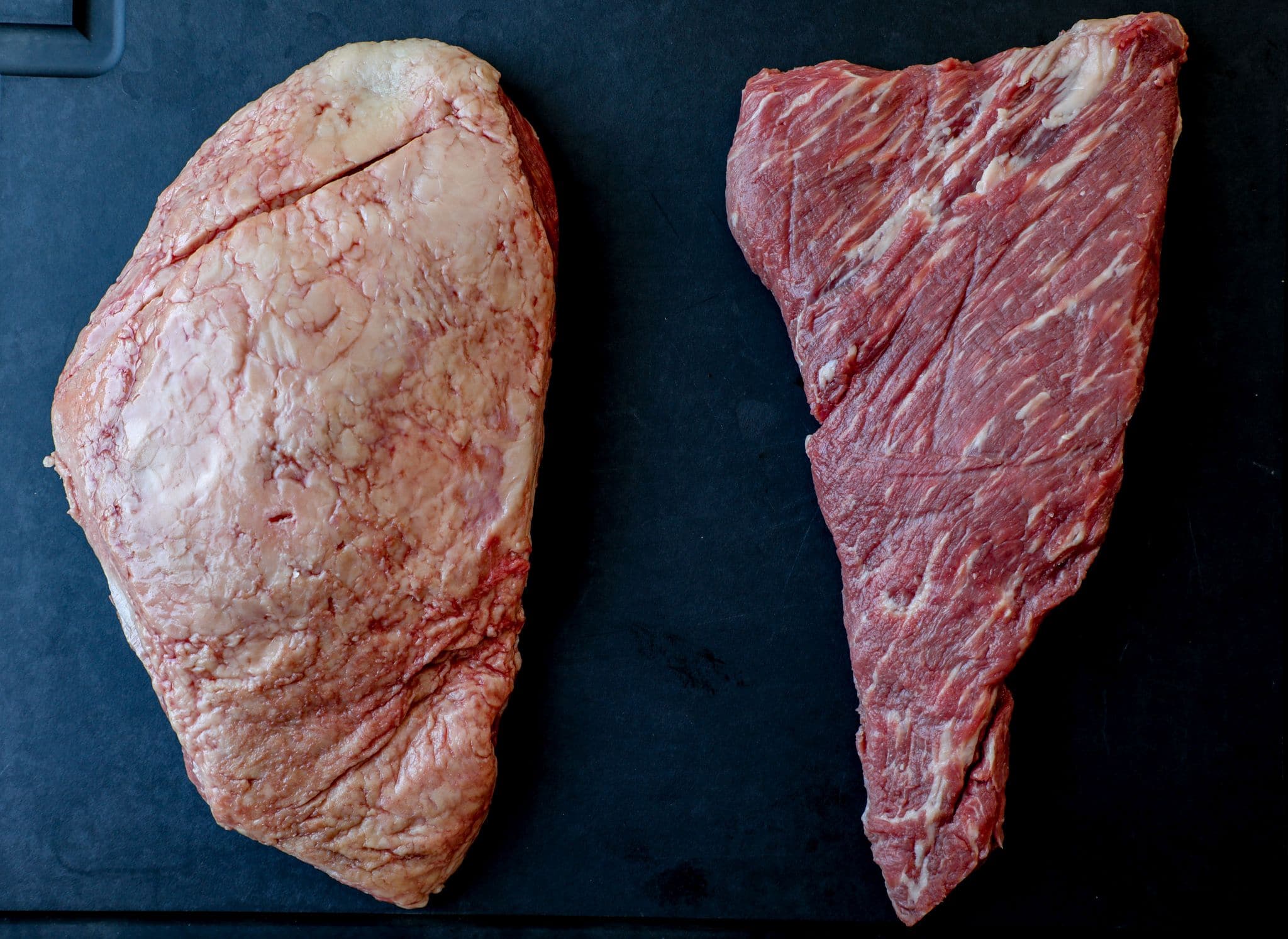
While both cuts are fairly lean and come from the sirloin area of the cow, overall the picanha tends to be a more tender cut of meat.
Why? A few reasons, the first being the location.
Picanha comes from the top sirloin portion of the cow, meaning the meat naturally has more marbling and fat.
These are key for both tenderness and a nice beefy flavor.
The second reason picanha is considered to be a more tender cut is because it contains a large thick layer of fat over the top of the meat.
As your meat cooks, that fat renders and adds more flavor and juiciness to the naturally lean muscle of this cut.
Does this mean tri tip isn’t good? Not at all!
It just means they are different types of meat and need to be treated as such (and why we season and sear using a variety of techniques to get the most out of each primal cut).
Depending on where you live, each of these cuts can be a little harder to find if you’re just walking up to your local grocery store. Each are much easier to find if you have a local butcher shop however.
Tri Tip: Tri tip is also often associated with being more of a “west coast” staple in the U.S and you often find it all over California and in places like New Mexico or Arizona.
While I have occasionally found it in stores like Whole Foods for example, most of the time these cuts are going to be something you order through your butcher or the many online meat retailers that have popped up over the last few years.
Tri tips also tend to be on the smaller side and tend to be a cheaper cut compared to the picanha. I like to use at least a 1.5 lb. tri tip or larger when possible.
Picanha: Make sure to find one that has excellent marbling and a solid fat layer over the top.
Sometimes you find it under different names when working with an American butcher, so be sure to talk to them if you can’t find this cut.
When working with large cuts of beef (like here with this smoked beef tenderloin) or any steak cut, seasoning in advance with kosher salt is a flavor game changer.
In the culinary world, we call this term dry brining. You may have heard of wet brining where you soak the meat in a salt and sugar water mixture (almost like a marinade).
This is essentially the same thing but without the extra liquid.
I actually prefer dry brining over wet brining for a lot of reasons (mostly for texture), but I especially love this with beef.
Why? Because when you work with larger, thicker cuts of steak its hard to season and penetrate the inside to add flavor.
The process of dry brining allows for the salt to dissolve on the surface, pull out moisture in the meat, and then lets it fully absorb and soak back in.
I mention this process in a lot of my smoked beef based recipes because it is a huge flavor game changer.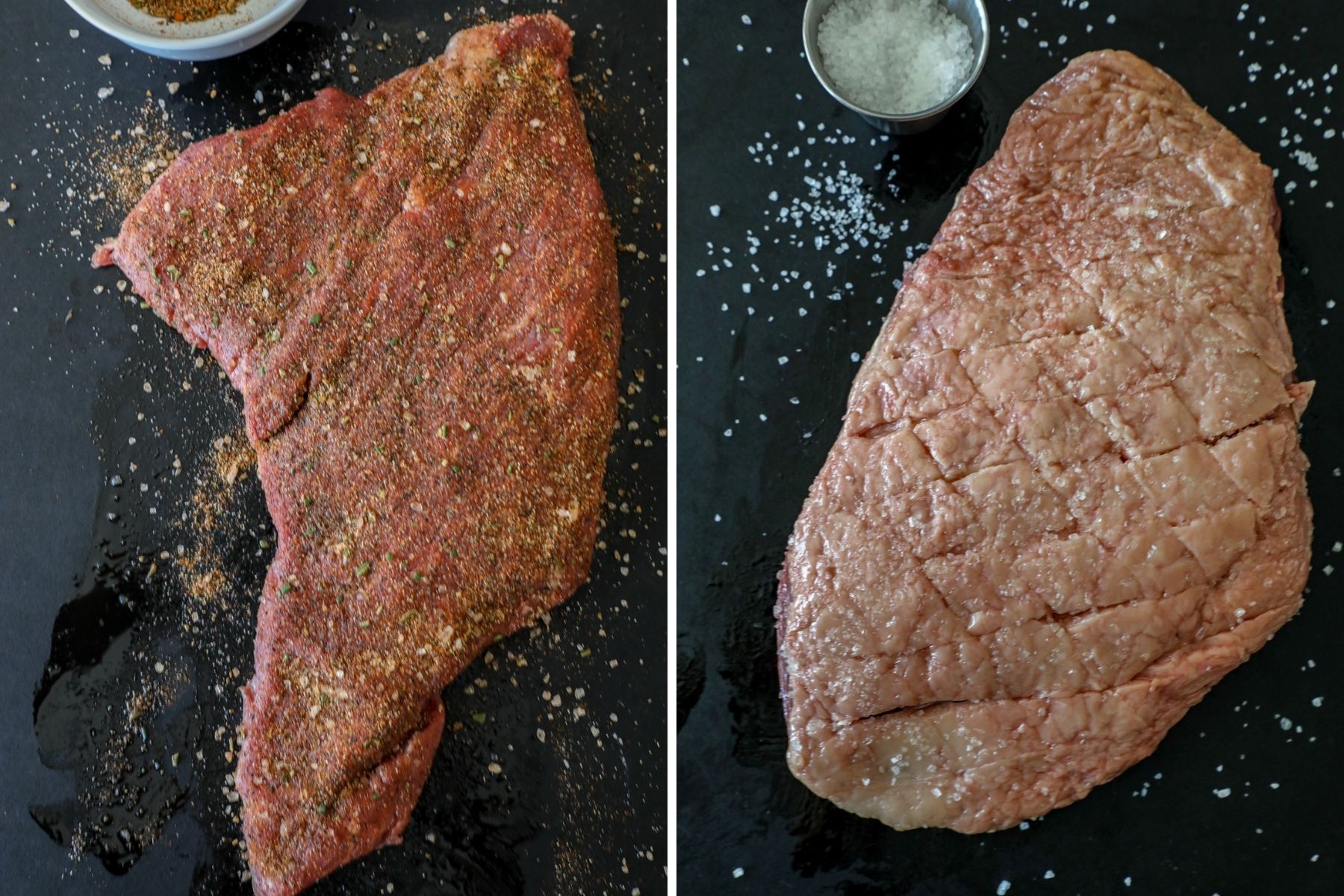
1. Plan for about 1 teaspoon of salt per pound of meat
2. Season all sides of the beef cut (including the fat side of the picanha in this case)
3. Let the meat sit for a minimum of 2 hours for this to work, but ultimately I like to do this 12-24 hours in advance
4. While salt is fine for both a standard tri tip or the Brazilian picanha you can also season with any dry rub too (like a Santa Maria rub for tri tip).
5. I prefer to score the top of the steak fat cap on the picanha to allow the salt to penetrate to the meat for this reason
6. Store the meat uncovered in the fridge as well to help slightly dry the surface to encourage browning and amp up the beef flavor
You can cook these cuts using a few different methods, such as:
–Oven roasting
–Sous Vide
–Grilling/ Smoking
–Open Fire (caveman style)
I find the best method for cooking both tri tip and picanha (or any thicker steak cut) is to use the reverse sear method.
Reverse searing starts by cooking your meat low and slow on indirect heat first, then searing for the nice brown outside crust over higher heat at the end.
This can be done using most of the methods listed above (sous vide, oven roasting with a pan sear to finish, and with grilling).
You can learn a lot more about this method by downloading my Bon Appeteach BBQ Basics free guide (highly recommend the tips used here to help you with these cooks and so many others as well).
– You can cook the picanha steak as a whole roast or sliced into steaks.
– If you sear picanha steaks, you can do so individually or by placing the meat onto long skewers.
– Start with room temperature meat when possible before cooking.
– Use a cast iron pan if reverse searing using an oven to help achieve that final crust.
– Resting time between the low and slow cook before the final sear helps prevent over cooking.
– For a medium-rare picanha or tri tip, use a good meat thermometer to help know when it’s fully cooked (I like both to hit an internal temperature of 125- 130 F.). 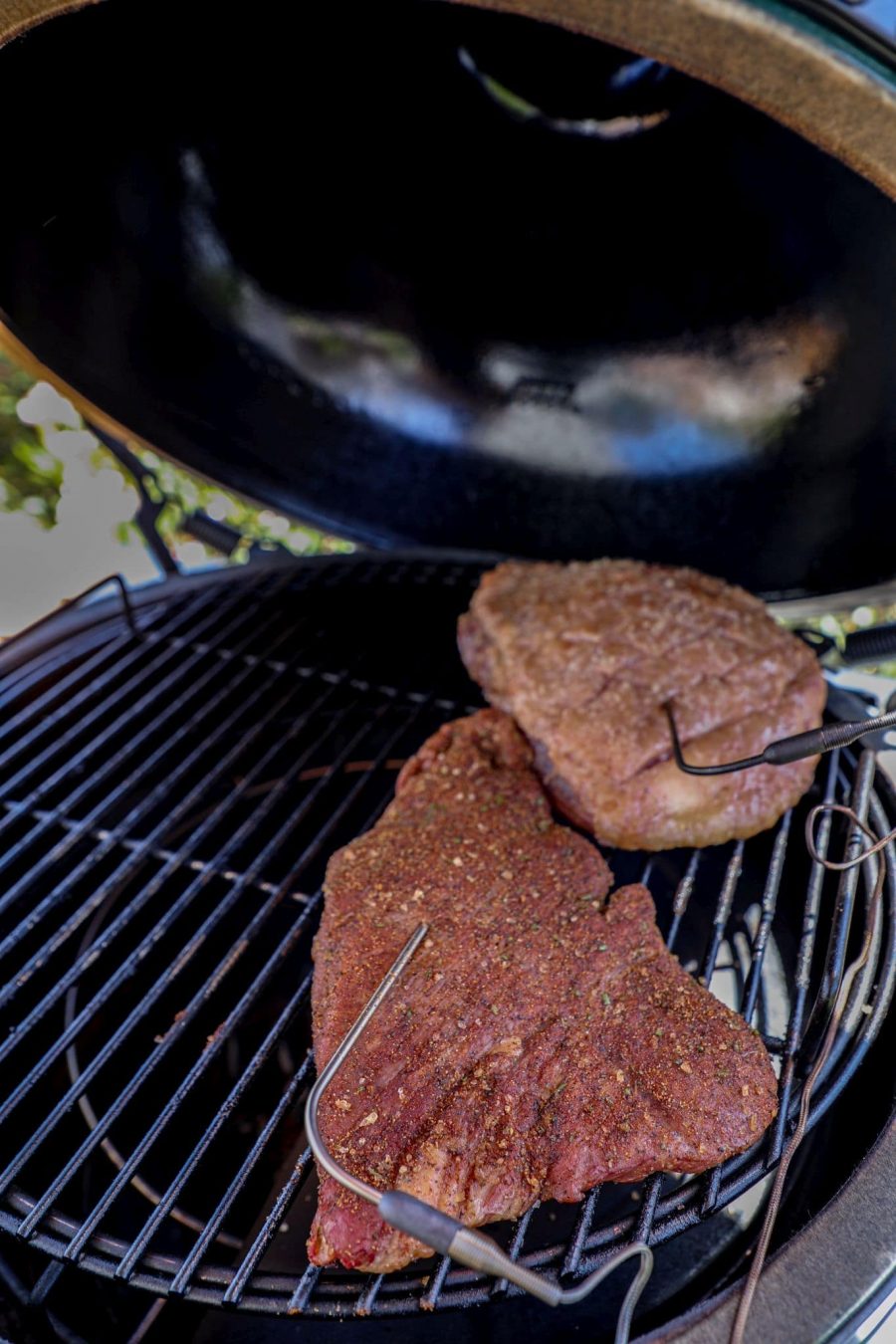
Always let your beef rest 10-15 minutes or so before slicing. This helps settle the juice inside the meat and prevent it from ending up only on your cutting board.
Both cuts should be sliced against the grain. A picanha steak should be cut into pieces on the larger side (I like one inch thick cuts).
A tri tip will need to be divided first and sliced two different ways because the meat grain runs two different ways. Reference this tri tip recipe for more information on slicing.
Serve both of these cuts with my smoked garlic cloves and a lot of fresh chimichurri for a beautiful presentation and for the best steak to server to friends and family.


